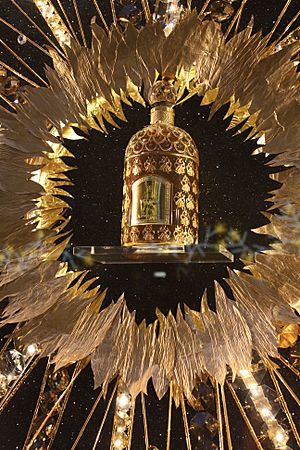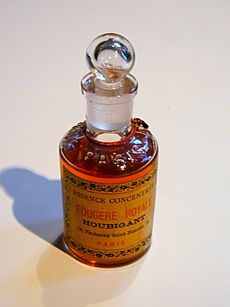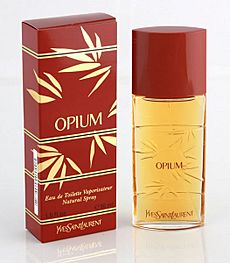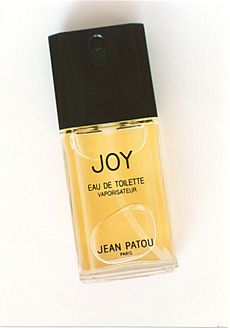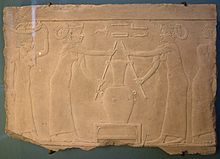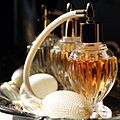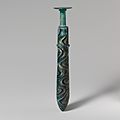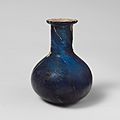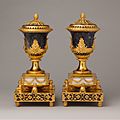Perfume facts for kids
Perfume is a special liquid that makes people, things, and rooms smell nice. It is made from oils that release a scent into the air around them. The smells in perfume can come from natural sources like plants and animals, or they can be made in a lab.
People have used perfumes since ancient times. Modern perfumes started to become popular in the late 1800s. This was when scientists learned to create new smells in labs, like vanillin. These man-made smells gave perfumers many more options than just natural ingredients.
Perfume smells stronger when it is warmer. That is why people often put it on warm parts of their body. These spots include the neck, wrist, and behind the knee. Eau de Cologne is a lighter type of perfume. You can splash it on your body, and it is not as strong as regular perfumes.
Contents
How to Describe Perfume
The exact recipes for perfumes are usually kept secret. Even if they were shared, they are so complex that it would be hard for most people to understand them. However, people who know a lot about perfumes can often tell what ingredients are in them. This is similar to how wine experts can identify different wines.
A good way to describe a perfume is by its "fragrance notes" or the "family" it belongs to. These things change how a perfume smells from the moment you put it on until its scent fades away.
The trail of scent a person leaves behind when wearing perfume is called its sillage. This word comes from French and means the "wake" left by a boat in water.
Perfume Families
It is hard to put perfumes into perfect groups because many scents have parts of different families. Even a perfume that smells mostly like one flower might have hints of other smells. There are very few perfumes that use only one scent.
Grouping perfumes into families helps us describe them. But it does not tell us everything about a perfume.
Old Categories
Here are some traditional perfume groups that started around the year 1900:
- Single Floral: These perfumes smell mostly like one specific flower. For example, Serge Lutens Sa Majeste La Rose.
- Floral Bouquet: These perfumes mix the scents of several different flowers. Examples include Houbigant Quelques Fleurs and Jean Patou Joy.
- Amber or "Oriental": This is a large group with sweet, warm scents. They often use smells like ambergris or labdanum. These are often mixed with vanilla, tonka bean, flowers, and wood. Examples are Guerlain Shalimar and Yves Saint Laurent Opium.
- Woody: These perfumes are dominated by wood smells. Common scents include agarwood, sandalwood, cedarwood, and vetiver. Patchouli is also often found in these perfumes. Examples are Myrurgia Maderas De Oriente and Chanel Bois des Îles.
- Leather: This group of perfumes has smells like honey, tobacco, and wood tars. They create a scent that reminds you of leather. Examples are Robert Piguet Bandit and Balmain Jolie Madame.
- Chypre: This name means Cyprus in French. These perfumes are built around bergamot, oakmoss, and labdanum. They became popular after François Coty's Chypre perfume in 1917. A modern example is Guerlain Mitsouko.
- Fougère: This means fern in French. These perfumes use lavender, coumarin, and oakmoss. They have a sharp, fresh, and woody smell. Many perfumes for men belong to this family. Examples are Fabergé Brut and Guy Laroche Drakkar Noir.
Newer Categories
Since 1945, new perfume groups have appeared. This is because new ways to create and mix scents were discovered. Also, tastes in perfumes changed over time.
- Bright Floral: This group combines the old Single Floral and Floral Bouquet types. An example is Estée Lauder Beautiful.
- Green: These are lighter and more modern versions of the Chypre type. They smell like cut grass, crushed green leaves, or cucumber. Examples are Estée Lauder Aliage and Calvin Klein Eternity.
- Aquatic, Oceanic, Ozonic: This is the newest group. It first appeared with Davidoff Cool Water in 1988. These perfumes have a clean smell like the ocean. They often contain a man-made chemical called calone.
- Citrus: This is an old perfume family. For a long time, it mostly included light "freshening" perfumes. Now, new ingredients allow for citrus perfumes that last longer. An example is Penhaligon's Quercus.
- Fruity: These perfumes feature fruits other than citrus. They can smell like peach, black currant, mango, or passion fruit. An example is Ginestet Botrytis.
- Gourmand: These scents smell like "edible" things or "desserts." They often have vanilla, tonka bean, and other ingredients that smell like food flavors. A sweet example is Thierry Mugler's Angel.
Fragrance Wheel
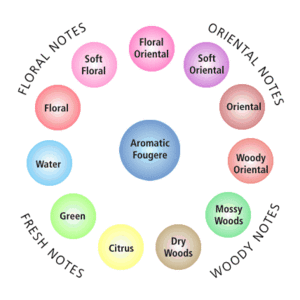
This newer way of grouping perfumes is used a lot in stores and by perfume makers. It was created in 1983 by a perfume expert named Michael Edwards. This system makes it easier to group and name perfumes. It also shows how different perfume families are related.
The five main families in this system are Floral, Oriental, Woody, Aromatic Fougère, and Fresh. The first four come from the old categories. The "Fresh" group comes from the modern oceanic scents. Each of these main families is divided into smaller groups and arranged around a wheel shape.
For example, Chanel No.5 is usually called an aldehydic floral. In this new system, it is placed in the Soft Floral group. Amber scents are part of the Oriental group. Some perfumes, like Chypre scents, can fit into more than one family. For instance, Guerlain Mitsouko is in Mossy Woods, but Hermès Rouge is in Floral Oriental.
History of Perfume
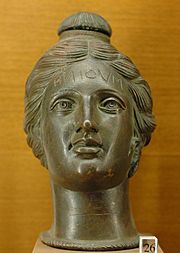
The word "perfume" comes from the Latin words per fumum, which mean "through smoke." Making perfumes, or perfumery, started in ancient Mesopotamia and Egypt. The Romans and Persians later made it even better.
The first chemist we know about was a woman named Tapputi. She was a perfume maker in Mesopotamia over 3,000 years ago. She would distill flowers, oil, and other smelly plants. She would filter them and distill them many times to get the best scent.
In 2005, archaeologists found what they think are the world's oldest perfumes in Pyrgos, Cyprus. These perfumes are more than 4,000 years old. They were found in an ancient perfume factory. Workers found at least 60 stills, mixing bowls, funnels, and perfume bottles there. In ancient times, people used herbs and spices like almond, coriander, myrtle, and bergamot. They also used flowers and tree resins.
An Arabian alchemist named Al-Kindi wrote a book about perfumes in the 800s. It had over a hundred recipes for fragrant oils and medicines.
The Persian chemist Avicenna found a new way to get oils from flowers. He used a process called distillation, which is still used today. He first tried this method with the rose. Before his discovery, liquid perfumes were just mixtures of oil and crushed plants. These made a very strong smell. Rose water, made by distillation, was much lighter and quickly became very popular.
The art of making perfume came to western Europe around the 1200s or 1300s. By the 1700s, plants used for perfume were grown in France, Sicily, and Italy.
Images for kids
-
Ancient Egyptian perfume vessel in shape of a monkey; 1550-1295 BC; faience; height: 6.5 cm, width: 3.3 cm, depth: 3.8 cm; Metropolitan Museum of Art (New York City)
-
Original Eau de Cologne flacon 1811, from Johann Maria Farina, Farina gegenüber
-
Resins in perfumery include myrrh
-
Itar (herbal perfume) vendor on the street of Hyderabad, India, who can compose an original perfume for the customer
-
A "perfume organ", where perfumers play around with hundreds of essences, in Grasse
-
An assorti of counterfeit perfumes (in a "kiosk" store)
-
Potpourri, by Edwin Austin Abbey, 1899
-
Ancient Egyptian perfume vase in shape of an amphoriskos; 664–630 BC; glass: 8 × 4 cm (3.1 × 1.5 in); Metropolitan Museum of Art (New York City)
-
Late Hellenistic glass gold-band mosaic alabastron (perfume bottle); 1st century BC; glass and gold leaf; Metropolitan Museum of Art
-
Roman perfume bottle; 1st century AD; glass; 5.2 x 3.8 cm; Metropolitan Museum of Art
-
British Rococo perfume vase; circa 1761; soft-paste porcelain; overall: 43.2 × 29.2 × 17.8 cm; Metropolitan Museum of Art
-
British Neoclassical pair of perfume burners; probably circa 1770; derbyshire spar, tortoiseshell, and wood, Carrara marble base, gilded brass mounts, gilded copper liner; 33 × 14.3 × 14.3 cm; Metropolitan Museum of Art
See also
 In Spanish: Perfume para niños
In Spanish: Perfume para niños


